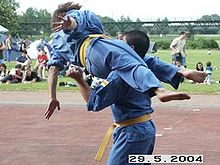- Indochinese martial arts
-
The traditional martial arts of the Indochinese peninsula are related among one another, and as a group to Chinese martial arts.
The most salient common feature is Indochinese kickboxing.
- Khmer Pradal Serey – Possible predecessor of Muay Thai with an emphasis on elbow techniques(Ring-wise).
- Thai Muay Boran (Ancient boxing) – Predecessor of Muay Thai, allows the use of headbutts.
- Thai boxing or Muay Thai – the modern Thai martial art with strong emphasis on knee and elbow strikes.[1]
- Burmese Lethwei, a traditional Burmese martial art of which has now grown into a popular kickboxing event with strong emphasis on knee, elbow strikes and headbutt. Any part of the body may be used to strike and be struck. It is also known as Bando kickboxing.
- Laotian Muay Lao – Laos kickboxing which is similar to Muay Thai
Contents
Burma (Myanmar)
Thaing (Burmese: သိုင်း, pronounced [θáiɴ]) is a Burmese term used to classify the traditional martial systems of Burma (or Myanmar).
The forms of thaing include Bando, Lethwei, Banshay and Naban. From these, non-competitive offshoot disciplines such as Min Zin, Burma Yoga (Bando yoga), Monk system (Pongyi thaing), Cardio lethwei, Aka were derived.
Cambodia
Main articles: Pradal serey, Bokator, Kbachkun Boran, Kbachkun Dambong-Veng, and Khmer traditional wrestlingPradal serey is an unarmed martial art from Cambodia. In Khmer the word pradal means fighting or boxing and serey means free. Originally used for warfare, pradal serey is now one of Cambodia's national sports. Its moves have been slightly altered to comply with the modern rules.
Laos
Muay Lao is a traditional unarmed martial art from Laos. It is similar to Muay Thai in Thailand, Pradal Serey in Cambodia, tomoi in Malaysia and as a similar art called lethwei in Myanmar. It incorporates punches, kicks, elbows and knee strikes. Muay Lao was an event at the 2009 Southeast Asian Games in Vientiane.
Malaysia
Tomoi is an unarmed martial art from Malaysia. It is closely related to other Indochinese boxing styles, such as as Muay Thai in Thailand, Pradal Serey in Cambodia, Muay Laoin Laos and lethwei in Myanmar. It is practiced mainly in the northern states such as Kedah, Trengganu, and especially Kelantan. Practitioners are called petomoi or anak tomoi.
The word tomoi is a cognate of the Thai term dhoi muay which refers to pugilism and fist-fighting in general. It was the original name for the old bare-knuckle style of Muay Thai now referred to as muay boran (ancient boxing).
Thailand
Muay Boran (Thai: มวยโบราณ, RTGS: Muai Boran, IPA: [mūɛj bōːrāːn], lit. "ancient boxing") is an umbrella term for the unarmed martial arts of Thailand prior to the introduction of modern equipment and rules in the 1930s. It is thus the direct ancestor of modern Muay Thai.[2]
The word muay which means "boxing" comes from the Sanskrit term mavya,[citation needed] while boran or boraan means "ancient" in Thai.[citation needed]
Muay Boran is not a single style but acts as an umbrella term for all traditional Thai styles of Indochinese kickboxing. Whereas Muay Thai is often called the "science of eight limbs", muay boran is said to make use of nawa awut which means "nine weapons", adding headbutts as ninth offensive in addition to the "eight limbs" of hands, legs, elbows and knees used in Muay Thai.
Vietnam
Vietnamese martial arts (Vo Thuat) are the traditional martial arts of Vietnam, closely related to the group of Chinese martial arts.
There was an academy of martial arts in the capital, Thăng Long, today's Hanoi, since the 11th century: Lý Dynasty (1009–1225), Trần Dynasty (1225–1400).[citation needed] The 16th to 18th centuries marked the country's division and the conflicts between the various lords. These antagonisms led to a diversion of the Vietnamese martial arts styles into different schools.[citation needed]
Modern styles include:
- Vovinam (Nguyen Loc 1938)
- Qwan Ki Do (1981)
- Nhat Nam (1983)
References
- ^ "Get in shape at a Thai kickboxing camp". USA Today. http://www.usatoday.com/travel/destinations/2008-10-13-thai-kickboxing_N.htm. Retrieved 2010-12-07.
- ^ "Fighting into the night". Malaysia Star. http://thestar.com.my/news/story.asp?sec=lifefocus&file=/2010/6/19/lifefocus/6483023. Retrieved 2010-12-07.
- Don F.Draeger and Robert W.Smith, Comprehensive Asian Fighting arts, E. Kodansha, Tokyo, 1969
See also
Categories:- Southeast Asian martial arts
Wikimedia Foundation. 2010.

